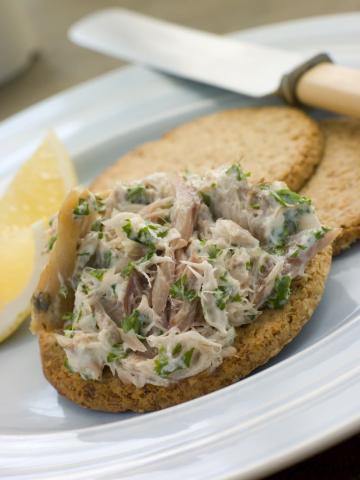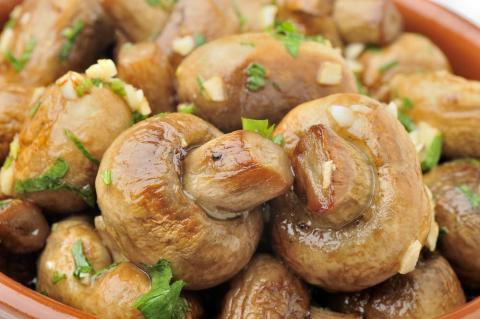- 1 ¾ Pints (1L) Water
- 1 (7g) Chicken or Vegetable Stock Cube (use reduced salt when possible)
- 2 (200g) Skinless And Boneless Chicken Thighs
- 2 Medium Sized (160g) Carrots
- 4 (40g) Spring Onions
- ½ Head (85g) Broccoli
- 10 Medium Sized (100g) Mushrooms
- 2 Teaspoons (10g) Soy Sauce (use reduced salt when possible)
- 1 Teaspoon (3g) Ground Ginger
- ½ Bag (175g) Rice Noodles
- 1 (3g) Garlic Clove or 1 Teaspoon (5g) Garlic Puree
- Pinch Chilli Flakes or Chilli Powder
Ingredients
Allergy Disclaimer
Always check the label of each ingredient for allergy warnings.
Method
- Make the stock by dissolving the stock cube in 1 litre of boiling water.
- Wash, peel and grate the carrots. If you don't have a grater, slice the carrots very finely.
- Wash and slice the spring onions.
- Wipe the dirt off the mushrooms and slice them.
- Separate the broccoli into small florets.
- Peel and crush, or finely chop, the garlic.
- Add the stock, chicken thighs, ginger, garlic, soy sauce and chilli flakes if using, to a large saucepan, and simmer for 10-15 minutes until the chicken is cooked.
- Remove the chicken thighs from the pan and chop into bite size pieces
- Add the carrots, broccoli, spring onions and mushrooms to the pan and cook for 5-10 minutes
- Add the noodles to the pan and cook for a further 2-3 minutes.
- Return the chicken to pan and serve hot.
Time Saver Tips
Why not make this in bulk without the noodles and freeze it? That way it’s easy to just reheat and add the noodles before plating up for a quick meal. Let it cool before freezing.
Cost Saver Tips
Any fine noodles can be used if rice noodles aren't available. And the soup tastes great with any veggies, so it’s good to use up whatever’s in your fridge. You don't have to use chicken thigh meat either, so can use any chicken that's on offer. This soup is also a good way to use up leftover chicken. In fact, it’s even easier – just skip the step where you cook the chicken and add the leftover chicken just before you put the noodles in. This will give enough time for it to heat through. Just remember, if the chicken’s been frozen before, you cannot freeze the soup. You could also make this vegetarian by using Quorn pieces, or vegetarian and vegan by using Tofu. You can also add tinned beans or chickpeas instead of chicken.
Tips for Kids
Chopping the vegetables extra small or blending them can be a fun idea that might help your kids eat more if they’re sometimes a bit fussy about their veggies. Why not ask them to help you prepare the vegetables? They could help grate carrots, slice mushrooms or separate the broccoli florets. They might be more likely to want to eat something they’ve helped to make. You could even let your wee one choose which vegetables to put in the pot – they’ll love picking their favourites!
Nutritional Information
Based on a single serving of 361g (% of an adult's reference intake)
Energy
235 kcals ( 12 %)
989 kJ ( 12 %)
Fat
0.5 g ( 3 %)
Saturates
39.8 g ( %)
Sugar
3.4 g ( 4 %)
Salt
1.2 g ( 20 %)
Detailed nutritional information
| Per 100g | Per 361g serving | |
|---|---|---|
| Energy Kcals | 65 | 235 |
| Energy Kj | 273 | 989 |
| Protein | 3.9 g | 14.1 g |
| Total Fat | g | g |
| Saturated Fat | 0.1 g | 0.5 g |
| Carbohydrates | 11 g | 39.8 g |
| Total Sugars | 0.9 g | 3.4 g |
| NSP Fibre | 0.5 g | 1.8 g |
| Sodium | 137 mg | 495 mg |
| Salt | 0.3 g | 1.2 g |
Find out about nutritional labelling
Nutrition labels on the front of packaging
- Most of the big supermarkets and many food manufacturers display nutritional information on the front of pre-packed food.
- Front of pack nutrition labels provide information on the number of grams of fat, saturated fat, sugars and salt and the amount of energy (in kJ and kcal) in a serving or portion of a recipe.
- The labels also include information about reference intakes (expressed as a percentage) which are guidelines about the approximate amount of particular nutrients and energy required for a healthy diet.
- The colour coding tells you at a glance if the food has high (red), medium (amber) or low (green) amounts of fat, saturated fat, sugars and salt.
- The more greens on the label, the healthier the choice
- Amber means neither high nor low, so you can eat foods with all or mostly ambers on the label most of the time.
- Reds on the label means the food is high in that nutrient and these are the foods we should cut down on. Try to eat these foods less often and in small amounts.
Food shopping tips
If you’re trying to decide which product to choose, check to see if there's a nutrition label on the front of the pack. This will help you to quickly assess how your choices stack up. You will often find a mixture of red, amber and green colour coding for the nutrients. So when you're choosing between similar products, try to go for more greens and ambers and fewer reds if you want to make a healthier choice.
 Activities & Play
Activities & Play Behaviour
Behaviour Childcare
Childcare Development & Growing Up
Development & Growing Up Family, Friends & Relationships
Family, Friends & Relationships Feeding Your Baby
Feeding Your Baby Food & Eating
Food & Eating Health & Safety
Health & Safety Mental Health & Wellbeing
Mental Health & Wellbeing Money & Work
Money & Work Online Behaviour & Safety
Online Behaviour & Safety Pregnancy & First Days
Pregnancy & First Days School & Education
School & Education Sleep
Sleep


















